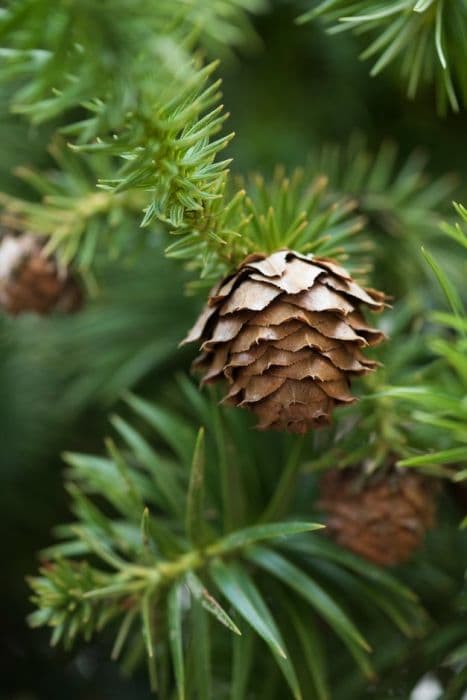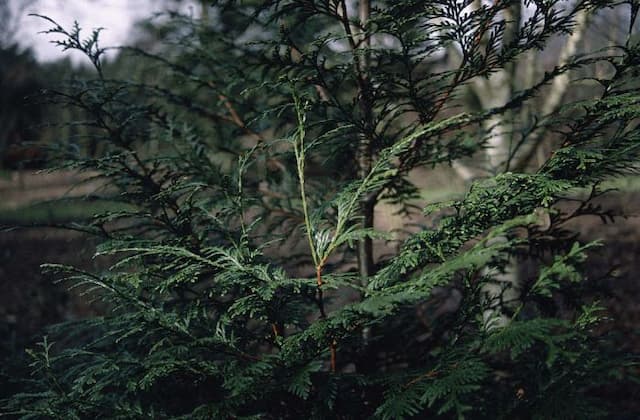Fire Chief Arborvitae Thuja occidentalis Fire Chief = 'Congabe' (PBR)

ABOUT
Thuja occidentalis Fire Chief, also known as the Fire Chief Arborvitae, is a distinctive coniferous shrub that is celebrated for its vibrant foliage. It has a naturally rounded, globe-like shape that provides a compact aesthetic. The plant's leaves, which are more accurately needles, exhibit a unique color transformation throughout the year. In springtime, the new growth emerges in a bright golden hue. As the seasons progress, the foliage's color deepens into a fiery reddish-orange, which is particularly striking in the autumn months. The intensity of the color can be influenced by the amount of sunlight the plant receives, often becoming more vivid with more exposure to the sun. The Fire Chief Arborvitae's needles are fine and soft to the touch, displaying a feathery texture that adds to its ornamental charm. What makes it particularly appealing is the way the foliage densely covers the shrub, creating a lush and full appearance that is visually pleasing. The plant's bark is not usually visible due to the thick coverage of foliage, but where it can be seen, it presents as a reddish-brown, which complements the fiery tones of the leaves. It produces small, inconspicuous cones that are less prominent than the foliage but add to the textural interest of the shrub. This cultivar is often chosen for its vivid coloring and its symmetrical, rounded form, which can serve as a focal point in landscape designs. It is commonly used in ornamental gardens for its year-round interest and color, and because it is evergreen, it retains its leaves throughout the year, providing continuous visual appeal in garden settings.
About this plant
 Names
NamesFamily
Cupressaceae
Synonyms
Fire Chief Arborvitae, American Arborvitae Fire Chief, Fire Chief White Cedar, Fire Chief Eastern Arborvitae
Common names
Thuja occidentalis Fire Chief = 'Congabe' (PBR).
 Toxicity
ToxicityTo humans
The common name of Thuja occidentalis Fire Chief = 'Congabe' (PBR) is the Eastern Arborvitae. There is some level of toxicity in this plant to humans, although it is usually not severe. If ingested, it can cause symptoms such as gastrointestinal upset, nausea, vomiting, and diarrhea. In some cases, there may also be skin irritation if there is prolonged contact with the foliage. It is important not to consume any part of the Eastern Arborvitae and to exercise caution when handling the plant if you have sensitive skin.
To pets
The common name of Thuja occidentalis Fire Chief = 'Congabe' (PBR) is the Eastern Arborvitae. This plant is also toxic to pets, which can include dogs, cats, and horses, among others. If pets ingest parts of the Eastern Arborvitae, they could exhibit symptoms such as drooling, vomiting, diarrhea, and in some cases, seizures or muscle weakness. It's important for pet owners to prevent their animals from chewing on or eating any part of the Eastern Arborvitae to avoid these adverse health effects.
 Characteristics
CharacteristicsLife cycle
Perennials
Foliage type
Evergreen
Color of leaves
Green
Height
4 feet (1.2 meters)
Spread
4 feet (1.2 meters)
Plant type
Shrub
Hardiness zones
5
Native area
North America
Benefits
 General Benefits
General Benefits- Year-Round Interest: 'Fire Chief' Arborvitae displays evergreen foliage that provides visual interest throughout all seasons.
- Compact Size: It naturally grows into a globe shape with a compact size, making it suitable for small gardens and landscaping.
- Low Maintenance: This cultivar is easy to care for, requiring minimal pruning and upkeep.
- Drought Tolerance: Once established, 'Fire Chief' Arborvitae is quite tolerant of drought conditions, reducing the need for frequent watering.
- Color Variation: The foliage offers a unique color transition from bright golden tips in spring, to orange-red hues in fall, enhancing garden aesthetics.
- Wildlife Habitat: Provides shelter for birds and other small wildlife within the landscape.
- Adaptability: 'Fire Chief' Arborvitae is adaptable to a range of soil types and environmental conditions.
- Hedging & Borders: Ideal for creating low hedges, borders, and formal garden structures due to its uniform growth habit.
 Medical Properties
Medical Properties- This plant is not used for medical purposes.
 Air-purifying Qualities
Air-purifying QualitiesThis plant is not specifically known for air purifying qualities.
 Other Uses
Other Uses- Artistic Topiary: Thuja occidentalis Fire Chief can be shaped into intricate topiary forms, providing unique and creative sculptures for gardens and landscapes.
- Wildlife Shelter: The dense foliage of the Arborvitae Fire Chief offers shelter and nesting sites for birds and small wildlife within a garden setting.
- Privacy Screens: Due to its thick growth, it can be used to create living privacy screens that are aesthetically pleasing while providing seclusion.
- Hedge: The Fire Chief variety can be planted in a row to form a natural and attractive hedge bordering property lines or garden sections.
- Windbreaks: These plants can be used to create windbreaks that protect more sensitive plants and reduce soil erosion in windy areas.
- Cultural Symbolism: In certain cultures, the Arborvitae is considered a symbol of long life and good health and can be planted with cultural intentions in mind.
- Focal Point Planting: Its unique color and shape make it an excellent choice for a focal point in garden design to draw the eye and add interest.
- Seasonal Decorations: The foliage and small cones can be used in wreaths and other decorative items during festive seasons such as Christmas.
- Erosion Control: Arborvitae Fire Chief’s root system helps stabilize soil on slopes and areas prone to erosion, preventing soil loss and runoff.
- Theme Gardens: Its fiery foliage color aligns well with autumn-themed gardens or as part of a color-specific planting scheme.
Interesting Facts
 Feng Shui
Feng ShuiThe American Arborvitae is not used in Feng Shui practice.
 Zodiac Sign Compitability
Zodiac Sign CompitabilityThe American Arborvitae is not used in astrology practice.
 Plant Symbolism
Plant Symbolism- Everlasting Life: Thuja occidentalis, commonly known as American Arborvitae or Eastern Arborvitae, is often associated with eternal life because of its evergreen nature, symbolizing immortality and eternal youth.
- Protection: The dense foliage and tall growth habit of the Arborvitae have made it a symbol of protection and privacy, often used in hedges and borders to shield against unwanted attention.
- Resilience: Arborvitae is known for its hardiness and ability to withstand harsh conditions, making it a symbol of resilience and perseverance in the face of adversity.
 Water
WaterThe Fire Chief Arborvitae should be watered thoroughly at planting and then as needed to keep the soil moist, but not soggy. Generally, this means watering once a week with about 1 to 2 gallons of water, but this can vary depending on the climate and soil conditions. In the first growing season, it's essential to ensure consistent moisture to help establish roots. In subsequent years, you can reduce watering frequency, but during dry spells, additional watering may be necessary.
 Light
LightThe Fire Chief Arborvitae thrives best in full sun to partial shade. Ideally, it should receive at least 4 to 6 hours of direct sunlight each day. This is crucial for maintaining its vibrant foliage color. The plant can also tolerate light shade, but the colors may not be as intense, and the growth may not be as dense.
 Temperature
TemperatureThe Fire Chief Arborvitae is hardy and can withstand a range of temperatures. It can survive minimum temperatures down to -40°F and maximum temperatures well above 100°F. However, the ideal temperature range for optimal growth is between 50°F and 70°F. It is important that the plant is not exposed to extreme heat without adequate moisture.
 Pruning
PruningPruning the Fire Chief Arborvitae is necessary to maintain its shape and size, and to remove any dead or damaged branches. The best time to prune is in early spring before new growth commences. Pruning can be done annually, as this will help to encourage denser foliage and maintain the desired spherical shape.
 Cleaning
CleaningAs needed
 Soil
SoilEastern Red Cedar, commonly known as Thuja occidentalis 'Fire Chief,' thrives in well-draining, loamy soil with a pH range of 6.0 to 8.0. A mix of two parts garden soil, one part peat moss, and one part perlite or coarse sand is ideal, ensuring sufficient drainage and aeration.
 Repotting
RepottingThuja occidentalis 'Fire Chief,' also called Eastern Red Cedar, should be repotted every 3-4 years, or when it has outgrown its current container, to ensure continued growth and health.
 Humidity & Misting
Humidity & MistingEastern Red Cedar prefers moderate humidity but is quite adaptable and can tolerate the dry to average humidity levels typical of most outdoor environments.
 Suitable locations
Suitable locationsIndoor
Place Eastern Red Cedar in a bright spot, avoid direct heat sources.
Outdoor
Plant Eastern Red Cedar in full sun to partial shade, mulch root area.
Hardiness zone
The Eastern Red Cedar is suitable for USDA hardiness zones 3-7.
 Life cycle
Life cycleThuja occidentalis Fire Chief, commonly known as Fire Chief Arborvitae or Eastern Arborvitae, begins its life as a seed that germinates in spring when soil temperatures are suitable. The seedling then develops into a juvenile plant, exhibiting rapid growth and the formation of its distinctive needle-like leaves. As the plant matures, it enters a phase of slower, more consistent growth, developing a rounded, compact shape with bright golden to red foliage that is maintained throughout the year. During its reproductive stage, typically when the tree is several years old, it produces small, inconspicuous cones that contain seeds for dispersal. These cones mature by late summer or early fall, after which they release seeds to start a new generation. The Fire Chief Arborvitae is relatively long-lived, capable of surviving for decades under appropriate conditions until it eventually succumbs to old age, environmental stress, or disease.
 Propogation
PropogationPropogation time
Spring-Early Summer
The most popular method for propagating the Fire Chief Arborvitae, or Thuja occidentalis 'Congabe', is through softwood cuttings. This is typically done in the late spring or early summer when new growth is soft and flexible. Cuttings should be 4 to 6 inches long and taken from the current year's growth. The bottom inch of each cutting should be stripped of foliage and then dipped in a rooting hormone powder to encourage root development. The treated end is then inserted into a well-draining potting mix. The cuttings should be kept in a humid environment with indirect light and consistent moisture until roots establish, which usually takes around 6 to 8 weeks. After rooting, the cuttings can be transplanted to individual pots or a prepared garden area.









